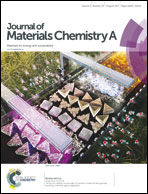High-strength graphene composite films by molecular level couplings for flexible supercapacitors with high volumetric capacitance†
Abstract
A critical challenge in fabricating the electrodes of flexible supercapacitors is to optimize their electrochemical performance without deteriorating their mechanical properties. We report here a strategy to prepare freestanding reduced graphene oxide@polyvinyl alcohol (rGO@PVA) composite films by synchronously reducing and assembling GO sheets with PVA molecules on a metal surface. Such rGO@PVA composite films realize the controllable assembly of rGO sheets and PVA in an ordered layered structure as well as the molecular level couplings between rGO sheets and PVA molecules. As a result, the rGO@PVA composite films display extremely high strength and Young's modulus. After introducing H2SO4, the PVA/H2SO4 electrolyte layer between rGO sheets can form fast ion transport channel at the molecular level in the composite films. Therefore, the composite films deliver high volumetric capacity (206.8 F cm−3), excellent energy density (7.18 mW h cm−3) and power density (2.92 W cm−3). More importantly, the supercapacitors based on the composite films show stable electrochemical performance under different stresses and bending states, even when the supercapacitors were bent to 180°. The high flexibility and electrochemical performance of such supercapacitors will enable a broad field of energy-storage devices to be compatible with flexible and wearable electronics.



 Please wait while we load your content...
Please wait while we load your content...